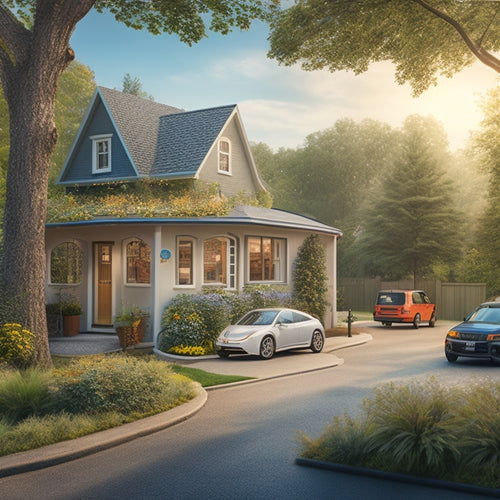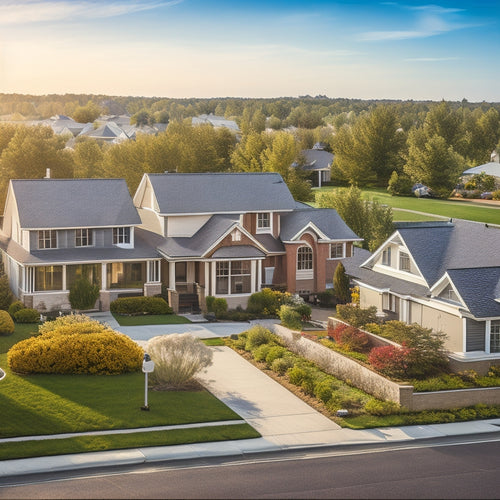
What Makes Autonomous Vehicles Safe on the Road?
Share
You're wondering what makes autonomous vehicles safe on the road. It's a combination of advanced technologies working together. Autonomous vehicles rely on advanced sensor and camera systems, real-time mapping and localization, and smart object detection capabilities to navigate roads safely. Predictive analytics and machine learning algorithms help identify potential hazards, while robust cybersecurity measures protect against threats. Redundant safety-critical systems and human oversight provide an extra layer of assurance. With these technologies in place, autonomous vehicles can detect and respond to hazards in real-time, ensuring your safety on the road. Want to know more about how these technologies work together to keep you safe?
Key Takeaways
• Advanced sensor and camera systems, calibrated for data accuracy, provide a 360-degree view of the road and surrounding environment.
• Real-time mapping and localization capabilities adapt to changing conditions, ensuring the vehicle stays on course and avoids obstacles.
• Smart object detection capabilities, powered by computer vision and machine learning algorithms, guide decision-making and contextualize objects for safe navigation.
• Predictive analytics and machine learning identify road hazards, anticipating risks and reassessing the road environment for enhanced situational awareness.
• Robust cybersecurity measures, redundant safety-critical systems, and human oversight ensure multiple layers of safety assurance in autonomous vehicles.
Advanced Sensor and Camera Systems
Equipped with a suite of advanced sensors and cameras, autonomous vehicles continuously gather and process vast amounts of data to navigate complex environments and guarantee safe operation. As you explore the intricacies of autonomous vehicle safety, you'll discover that these sensors and cameras work in harmony to provide a thorough view of the surroundings.
Sensor calibration plays an essential role in ensuring the accuracy of this data, as even slight miscalibrations can have significant consequences. You'll find that visual inspection is an important step in this process, allowing for the detection of any anomalies or malfunctions.
By combining data from various sensors, such as lidar, radar, and cameras, autonomous vehicles can create a precise and reliable picture of their environment. This fusion of data enables them to make informed decisions, respond to unexpected situations, and maintain a safe distance from obstacles.
With advanced sensor and camera systems working together seamlessly, you can trust that autonomous vehicles are designed to prioritize safety above all else.
Real-Time Mapping and Localization
As you navigate complex environments, autonomous vehicles continuously update and refine their internal maps, guaranteeing accurate real-time mapping and localization. This process is vital for safe and efficient autonomous navigation.
The vehicle's onboard computer processes a vast amount of data from various sensors, such as GPS, lidar, and cameras, to create a precise and up-to-date map of its surroundings. Map accuracy is essential, as even slight deviations can lead to navigation errors. Environmental factors, like weather, roadwork, or construction, are also taken into account to make sure the vehicle adapts to changing conditions.
For instance, a rainy day may require adjustments to sensor calibration or braking distance. The vehicle's real-time mapping and localization capabilities enable it to detect and respond to these environmental factors, ensuring a smooth and safe ride.
Smart Object Detection Capabilities
By leveraging advanced computer vision and machine learning algorithms, you can depend on autonomous vehicles to detect and classify objects in their surroundings with significant precision, allowing them to anticipate and respond to potential hazards in real-time.
This capability is vital for safe navigation, as it enables the vehicle to identify and differentiate between various objects, such as pedestrians, cars, bicycles, and road signs. Object classification is a key aspect of smart object detection, where the vehicle's system accurately identifies the type of object and its relevance to the driving scenario.
This information is then used to guide the vehicle's decision-making process, ensuring a safe and efficient journey. Moreover, scene understanding is also critical, as it enables the vehicle to contextualize objects within the environment, taking into account factors like distance, speed, and trajectory.
Predictive Analytics and Machine Learning
As you explore the role of predictive analytics and machine learning in autonomous vehicles, you'll see how these technologies enable the prediction of road hazards, allowing the vehicle to take proactive measures to mitigate risks.
You'll discover how real-time risk assessment enables the vehicle to constantly evaluate its surroundings and adjust its behavior accordingly.
Predicting Road Hazards
You can greatly improve the safety of autonomous vehicles by leveraging predictive analytics and machine learning to identify potential road hazards before they occur. By analyzing vast amounts of data, including historical traffic patterns, weather conditions, and road maintenance records, you can create detailed hazard profiles that anticipate potential risks on the road.
For instance, you can use weather modeling to predict when and where flooding, fog, or icy roads are likely to occur, allowing the vehicle to adjust its route or speed accordingly. By integrating this data with real-time traffic updates, you can identify high-risk zones and take proactive measures to mitigate potential hazards.
Real-time Risk Assessment
Your autonomous vehicle's real-time risk assessment capabilities rely on the fusion of predictive analytics and machine learning algorithms to continually reassess the road environment. This fusion enables your vehicle to anticipate and respond to potential hazards in real-time.
By analyzing vast amounts of data, the vehicle's system identifies potential risk scenarios and generates hazard profiles to predict the likelihood of accidents. These profiles are constantly updated based on new data, allowing the vehicle to adapt to changing road conditions.
For instance, if the system detects a pedestrian stepping onto the road, it will instantly reassess the risk scenario and adjust the vehicle's speed and trajectory accordingly. This real-time risk assessment enables your autonomous vehicle to take proactive measures to prevent accidents, ensuring a safer ride.
Enhanced Situational Awareness
By integrating predictive analytics and machine learning algorithms, enhanced situational awareness allows your autonomous vehicle to perceive its surroundings more accurately, detecting potential hazards and responding accordingly. This advanced technology enables your vehicle to anticipate and react to complex scenarios, ensuring a safer ride.
Through contextual analysis and environmental scanning, your vehicle can detect subtle changes in its environment, such as:
-
Pedestrian behavior: Identifying patterns in pedestrian movement to anticipate potential risks.
-
Weather conditions: Adjusting speed and trajectory to compensate for rain, snow, or other hazardous weather conditions.
-
Road surface conditions: Detecting potholes, oil slicks, or other hazards that could affect vehicle stability.
- Vehicle-to-vehicle communication: Sharing data with other vehicles to anticipate and respond to potential collisions.
Cybersecurity Measures in Place
To safeguard against potential cyber threats, autonomous vehicle manufacturers have implemented robust cybersecurity measures, including multi-layered defense strategies and regular software updates, to protect their systems from hacking and unauthorized access. As you step into an autonomous vehicle, you can rest assured that the network architecture is designed with security in mind.
The vehicle's systems are segmented into isolated zones, each with its own set of access controls, ensuring that even if one zone is compromised, the others remain secure.
Encryption protocols, such as AES and SSL/TLS, are used to protect data in transit, making it difficult for hackers to intercept and exploit sensitive information. Additionally, autonomous vehicle manufacturers are adopting a 'defense-in-depth' approach, where multiple layers of security controls are implemented to prevent a single point of failure.
This includes intrusion detection and prevention systems, secure boot mechanisms, and secure communication protocols. With these measures in place, you can feel confident that your autonomous vehicle is protected from cyber threats, allowing you to focus on the road ahead.
Redundancy in Safety-Critical Systems
As you rely on autonomous vehicles to navigate complex road scenarios, redundant safety-critical systems guarantee that multiple failures won't compromise your safety. This redundancy assures that if one system fails, another takes over seamlessly, safeguarding your safety on the road.
Here are some ways redundancy is implemented in autonomous vehicles:
-
Dual sensing systems: Multiple sensors, such as cameras, lidar, and radar, provide redundant data to ensure accurate object detection and tracking.
-
System Failovers: In the event of a system failure, backup systems take over to maintain vehicle operation and safety.
-
Diagnostic Tools: Built-in diagnostic tools monitor system performance and detect potential issues before they become safety-critical.
- Triple redundancy in critical systems: Critical systems like braking and steering have triple redundancy to guarantee that even if two systems fail, the third can still operate safely.
Human Oversight and Intervention
While riding in an autonomous vehicle, you can feel secure knowing that human oversight and intervention are always available to step in and correct the vehicle's actions if needed. This added layer of safety provides an extra level of assurance, as humans can monitor and correct the vehicle's decisions in real-time.
Driver monitoring systems track the autonomous vehicle's performance, identifying potential issues before they become safety risks. If an issue arises, remote assistance teams can take control of the vehicle, providing immediate intervention to prevent accidents. This human oversight guarantees that the vehicle operates within predetermined safety parameters, ensuring a safe and reliable ride.
With remote assistance, the response time is notably reduced, allowing for swift correction and minimizing the risk of accidents. By combining autonomous technology with human oversight and intervention, autonomous vehicles can operate with an unparalleled level of safety, providing passengers with a secure and confident travel experience.
Continuous Software Updates and Testing
Your autonomous vehicle's software is constantly refined through continuous updates and rigorous testing, ensuring you benefit from the latest advancements in safety and performance. This process involves a series of critical steps to guarantee the reliability of the system.
To achieve this, developers employ various techniques, including:
-
Code refactoring: Restructuring the codebase to improve its maintainability, scalability, and performance, ensuring the system remains efficient and adaptable.
-
Bug prioritization: Identifying and addressing critical bugs and errors, prioritizing those that pose the greatest risk to safety and performance.
-
Regular security audits to identify vulnerabilities and implement patches before they can be exploited.
- Rigorous testing protocols: Simulating real-world scenarios to test the system's response to various conditions, ensuring it can handle unexpected events.
Through these measures, your autonomous vehicle's software is continually refined, providing a safer and more reliable driving experience.
Frequently Asked Questions
Can Autonomous Vehicles Operate in Extreme Weather Conditions?
When you're driving an autonomous vehicle in extreme weather, you depend on precise sensor calibration and accurate weather forecasting to guarantee safe navigation, as faulty readings can lead to disastrous consequences.
Do Autonomous Vehicles Obey All Traffic Laws and Regulations?
You'll be relieved to know that autonomous vehicles are programmed to obey all traffic laws and regulations, adhering to strict compliance standards and incorporating safety protocols to minimize risks on the road.
How Do Autonomous Vehicles Handle Unexpected Road Closures?
You'll be relieved to know that autonomous vehicles, like yours, use advanced route planning to detect unexpected road closures, instantly recalculating a new route via emergency routing, ensuring a safe and efficient journey.
Can Autonomous Vehicles Be Hacked or Compromised Remotely?
As you navigate the digital highway, you wonder if autonomous vehicles can be hacked or compromised remotely. The answer is yes, they're vulnerable to cybersecurity threats, susceptible to remote exploitation, and can be manipulated by malicious actors.
Are Autonomous Vehicles Insured Differently Than Human-Driven Vehicles?
You'll find that autonomous vehicles are insured differently, with a liability shift from drivers to manufacturers, resulting in unique premium rates that account for reduced human error and increased tech-related risks.
Related Posts
-

Why Higher Upfront Costs Are Worth It
You pay a premium for high-quality, energy-efficient products, but they're worth it. With durability testing ensuring...
-

Why Nearby EV Conversion Shops Matter to You
Having a nearby EV conversion shop means you'll experience the benefits of a more personalized, convenient, and susta...
-

Why Invest in Residential Solar Panel Systems?
By investing in a residential solar panel system, you'll harness renewable energy, reducing your carbon footprint and...


